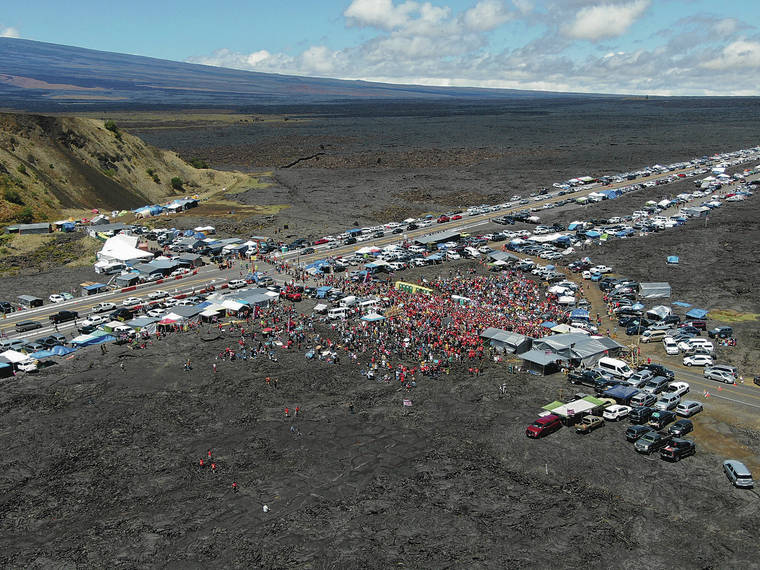Police step up traffic and parking enforcement near Mauna Kea protest site

COURTESY NA’ALEHU ANTHONY
An aerial view of the intersection of Daniel K. Inouye Highway and Mauna Kea Access Road on Aug. 11.
MAUNA KEA >> Hawaii County police have stepped up their ticketing of vehicles parked or traveling near the Mauna Kea protest site, issuing about 100 citations per day in the area since late last week. Protest leaders say that new enforcement push seems designed to put a damper on the opposition to the Thirty Meter Telescope.
But police Major Sam Jelsma said Monday the protesters or “protectors” on Mauna Kea are not being targeted. There have been two serious accidents in the area since the protests began more than a month ago, and Jelsma said officers are issuing tickets when they see violations by any motorists — not just by the activists involved in the protests.
“We’ve got all of these officers up there, and we’re kind of waiting for something to happen, so we’re doing what police do, so we’re out there enforcing,” he said. “For the record, we are not targeting protesters. We are targeting violations on DKI (Daniel K. Inouye) Highway.”
“There is increased traffic up here due to the protest movement,” he said. “Obviously, with people camping out on the side of the road, there is a need for increased police presence, which will make things safer.”
Jelsma declined to say how many officers are in the area, but said both patrol officers and police special response team members are working on traffic enforcement. Police are also setting up drunken driving roadblocks and setting up posts for seat belt enforcement in the area, he said.
Andre Perez, a leader in the protest movement against the TMT, said Monday the activists are still trying to figure out what the police activity is all about.
Don't miss out on what's happening!
Stay in touch with breaking news, as it happens, conveniently in your email inbox. It's FREE!
“It looks like they’re trying to minimize us and marginalize us being here by enforcing traffic regulations and setbacks from the highway and ticketing anything they can ticket, really, so we’re still trying to figure out where that’s coming from and why, but it’s pretty obvious that it’s an attempt by the county to just control and limit the amount of people here,” he said.
“If they’re going to do some kind of selective enforcement, it is a problem,” Perez said.
Parking also appears to be an issue. There is a surge of people to the protest site each weekend, with thousands of activists arriving at the intersection of the highway and the Mauna Kea Access Road on some weekends, and many hundreds of vehicles parked along the highway.
Kaho’okahi Kanuha, another leader in the protest movement, said state Department of Transportation officials put up signs Monday prohibiting parking, stopping, standing, loading or unloading for 3,000 feet in each direction from the access road intersection.
“I get it that there are rules and laws that have to be followed for vehicles, and I expect those things to be followed, but what we do see here is that it seems they are specifically targeting people here,” Kanuha said.
“They claim it’s for safety,” but if the concern really was for safety, Kanuha said he expects the state would install additional barricades along the highway to separate pedestrians and parked cars from passing traffic. State DOT installed a number of barricades on both sides of the highway in the first days of the protest in mid-July.
“To threaten people with tickets and fines and towing under the premise of safety is something that I find a little disingenuous,” he said. The protest leaders are warning visitors to the camp of the extra enforcement effort, and also put messages out on social media on the subject.
Perez said police have not communicated directly with the protest leaders on any specific changes that need to be made in the parking arrangements. Kanuha said he was told vehicles along the highway need to be parked a “reasonable distance” from the paved shoulder, and said he has asked for better guidance on what will be allowed.
Jelsma noted the new signage was installed by state DOT, and “as far as the distance … we are also seeking clarification from them on that.”
The protests over the $1.4 billion TMT project are now in their fifth week, and at times thousands of opponents of the project have gathered around the intersection of Daniel K. Inouye Highway and Mauna Kea Access Road. The access road has been closed since July 15, and police arrested 38 people for blocking the access road on July 17.
The protesters consider the TMT project to be a desecration of a mountain that many Hawaiians consider sacred, and say they will not allow it to be built. But sponsors of the TMT project spent a decade navigating the state and county permitting processes and fending off legal challenges to the project, and TMT supporters say the project now has the legal right to proceed.
Jelsma said there have been concerns raised that there is not enough of a visible police presence in the area around the highway intersection with the Mauna Kea Access Road, “so we are showing that police presence and essentially enforcing the traffic rules as they apply to vehicles on DKI highway.”



